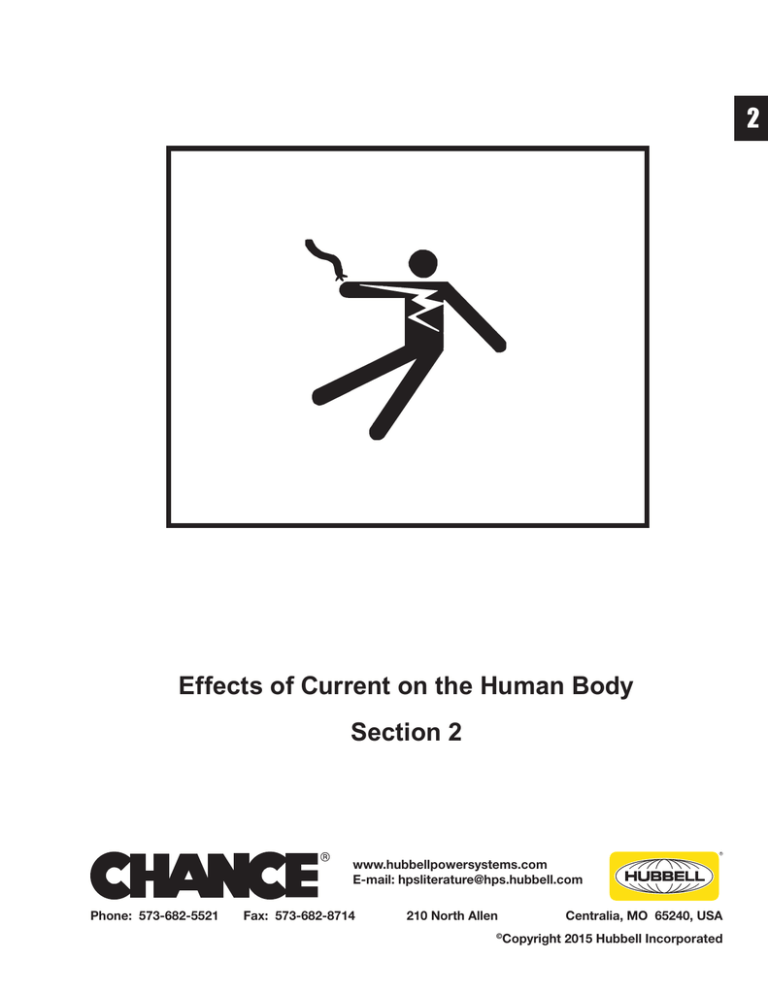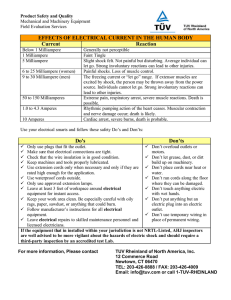Effects of Current on the Human Body Section 2
advertisement

2 Effects of Current on the Human Body Section 2 www.hubbellpowersystems.com E-mail: hpsliterature@hps.hubbell.com Phone: 573-682-5521 Fax: 573-682-8714 210 North Allen Centralia, MO 65240, USA Copyright 2015 Hubbell Incorporated © Effects of Current on the Human Body Charles Dalziel[18,19] did much of the early research on the human body’s reaction to current in the late 1940s and early 1950s. He used volunteers in his experiments and found that the body reacts to different levels of electrical current in different ways. For the safety of the volunteers, this research was conducted only at low levels of current, with medical personnel present. Later, additional research was carried out to determine the correctness of extrapolating Dalziel’s findings to higher current levels. electric shock energy tolerated by a certain percentage of the population studied. By monitoring the voltage applied, the resulting current flow, and the reaction of the volunteers, a great deal of information was developed. Calculations were made to develop a value of resistance for the “average” human body. Voltages during some of the experiments were measured at 21 volts hand to hand and 10 volts from one hand to the feet. Calculations of resistance using the measured values yielded 2,330 ohms hand-to-hand and 1,130 ohms hand-to-feet. This early low voltage research established an average safe let-go current for an “average” man as 16 milliamperes. It was also determined that the human body responds to current in an exponential manner. That is, the body responds to an increasing current as the time shortens in a similar manner as it responds to a decreasing current and lengthening duration. This time current relationship is shown in Figure 2-1. Using this formula, it can be determined that on average a 110 lb. lineworker should withstand 67 milliamps for 3 seconds before going into heart fibrillation and a 155 lb. worker would withstand 91 milliamps. Or the same workers would be susceptible to heart fibrillation after a 670 Amp. and 906 Amp. shock respectively after only 0.03 seconds, or about 2 cycles of 60 Hz. current flow through the chest cavity. However, at these current levels other injuries may occur, such as burns if arcing is present. Values presented in tables are commonly rounded to even values of current for ease of presentation and remembering. √ t I = k/ (Eq. 1) Where I= Current in milliampere K= function of shock energy = k50 is 116 for a 50 kg (110 lb.) body wt. = k70 is 157 for a 70 kg (155 lb.) body wt. t= time in seconds Dalziel’s research also formed the basis of the chart [18, 19] that is used throughout the industry today. The chart presents several levels of current and the average body’s response. The table for 60 Hz. is presented in Table 2-1. Dalziel’s research culminated in Equation 1, which follows [15]. It relates current amplitude and duration of flow through the heart to the threshold of ventricular fibrillation. Statistical studies have shown that 99.5% of all persons can withstand the passage of a current magnitude (I) for the duration indicated (t) in this equation without going into ventricular fibrillation. The value k is an empirical constant, statistically determined, related to the 2-2 EffectMen Women No sensation on the hand 0.4 0.3 Slight Tingling (Perception Threshold) 1.1 0.7 Shock, not painful & muscle control not lost 1.8 1.2 Painful Shock, painful but muscle control not lost 9.0 6.0 Painful Shock (Let Go Threshold) 16.0 10.5 Painful & Severe Shock, muscles contract, breathing difficult 23.0 15.0 From short shocks (0.03 Sec.) 1,000 1,000 From longer shocks (3.0 Sec.) 100 100 Possible Ventricular Fibrillation Ventricular Fibrillation, Certain Death Must occur during susceptible phase of heart cycle to be lethal. From short shocks (0.03 Sec.) 2,750 2,750 From short shocks (3.0 Sec.) 275 275 All values are milliampere RMS at 60 Hz. Reaction to Various Currents By the “Average” Body Table 2-1 Current milliampere (mA) 0 0.03 3.0 Time (Sec.) Fig. 2-1 2-3 The published literature typically presents resistance values between extremities. Values are typically given from hand to hand, a hand to both feet or from one foot to the other foot. Literature typically presents the body resistance as either 500 Ohms or 1,000 Ohms[1]. Neither is truly representative of a specific, individual worker. Many other factors have an affect upon the total lineworker resistance, such as: Are gloves being worn? What are they made of? Are boots with insulating or conducting soles being worn? How callused are the worker’s hands? The actual resistance of an working individual may vary from the 500 Ohms value to a few thousand Ohms. less than 0.5 sec. from the beginning of the first, the combined durations of the two should be considered as one[1]. The short interval without current does not provide sufficient time for the person to recover from the first shock before receiving the second. It is agreed that the most serious current path involves the chest cavity. That of handto-foot may be less dangerous but still may be fatal. Keep in mind that while a shock may be painful but not fatal, it may cause a related accident. A shock reaction may cause a loss of balance, a fall or the dropping of equipment. For voltages at or above 1,000 Volts (1 kV) and currents above 5 amperes, the body resistance decreases because the outer skin is often punctured and the current travels in the moist inner tissue, which has much lower resistance. Burns of the body’s internal organs can result from this type of current passage. Most literature of today assumes a body resistance of 1,000 Ohms but more and more utilities are using a 500 Ohm value to err on the side of safety. While this is an approximate value, it allows calculations and comparisons between safety equipment offerings to be made. Resistance may be added to include the wearing of protective leather gloves or shoes. The use of an alternate body resistance beyond those defined in standards, to meet individual utility requirements, is left up to the user. The protection methods discussed later are designed to ensure the body voltage is maintained below a selected safe level. It must be reduced from the high current level that results in burns or serious injury to a level below that of heart fibrillation. If re-closing is not disabled, a second shock may occur soon after the first. If it occurs in Notable Currents Are: Perception Level (the least amount of current detectable by the ungloved hand) = 1.1 milliampere* Painful Shock, painful but muscle control not lost = 9 milliampere* Painful Shock (Let Go Threshold) = 16 milliampere* Possible Ventricular Fibrillation: With a duration of 0.030 Sec. > 1,000 milliampere* With a duration of 3.000 Sec. > 100 milliampere* *These are average levels for men, empirically developed from Charles Dalziel’s[18,19] research. 2-4




